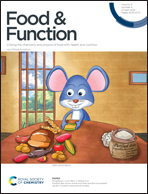Pre-diagnosis meat intake and cooking method and ovarian cancer survival: results from the Ovarian Cancer Follow-Up Study (OOPS)†
Abstract
Objectives: The relationships between pre-diagnosis meat intake and ovarian cancer (OC) survival were limited and controversial. To date, no study has taken account of cooking methods. Thus, we aimed to firstly clarify these associations based on the Ovarian Cancer Follow-Up Study. Methods: This prospective cohort study, including 853 OC patients between 2015 and 2020, was conducted to examine the aforementioned associations. All women completed a food frequency questionnaire. Deaths were ascertained up to March 31, 2021 via medical records and active follow-up. We used the Cox proportional hazards model to estimate hazard ratios (HRs) and 95% confidence intervals (CIs). Results: During the median follow-up of 37.17 months, 130 women died. Pre-diagnosis fish and seafood intake was associated with better survival (HRT3 vs. T1 = 0.46, 95% CI = 0.26–0.82, p trend <0.05), whereas processed red meat (HR = 1.54, 95% CI = 1.04–2.26) and a high frequency of fried fish intake (HR = 1.49, 95% CI = 1.03–2.16) were associated with worse survival than consuming none. After considering the interaction of cooking methods, we found that compared with the lowest tertile of fish and seafood intake and almost no fried fish cooking, women with the highest tertile of intake and almost no fried fish cooking had better survival (HR = 0.35, 95% CI = 0.13–0.92). Additionally, compared with the lowest tertile of fish and seafood intake and almost no baked fish cooking, women with the lowest tertile of intake and consuming baked fish had worse survival (HR = 3.75, 95% CI = 1.53–9.15). Conclusions: Pre-diagnosis fish and seafood intake was associated with better OC survival, whereas processed red meat intake was associated with worse survival. Cooking methods, especially for fried or baked fish, may play interaction effects with fish intake on OC survival.



 Please wait while we load your content...
Please wait while we load your content...